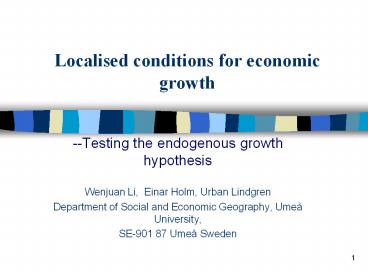Localised conditions for economic growth - PowerPoint PPT Presentation
1 / 14
Title:
Localised conditions for economic growth
Description:
Localised conditions for economic growth--Testing the endogenous growth hypothesis Wenjuan Li, Einar Holm, Urban Lindgren Department of Social and Economic Geography ... – PowerPoint PPT presentation
Number of Views:131
Avg rating:3.0/5.0
Title: Localised conditions for economic growth
1
Localised conditions for economic growth
- --Testing the endogenous growth hypothesis
- Wenjuan Li, Einar Holm, Urban Lindgren
- Department of Social and Economic Geography, Umeå
University, - SE-901 87 Umeå Sweden
2
Background of the research project
- PhD thesis Firms and People in PlaceDriving
forces for regional growth - Regional growth? employment? labour market
- Labour marketlabour demand and labour supply
- labour demand workplace
3
Literatures related to regional growth (1)
- Neoclassical growth models
- assuming decreasing marginal returns to scale
predict a convergence of economies in regions and
countries which does not seem to have been the
case when comparing growth rates in developing
and developed countries during the last 50 years.
- neoclassical models do not explain why
technological shifts occur.
4
Literatures related to regional growth (2)
- New growth Models
- Endogenously closed economic systems (e.g. a
region or a country) can become self-sustaining
and experience dynamically increasing returns
(Arrow, 1994 Arthur, 1994 Karlsson et al, 2001)
- The increasing returns are achieved by
externalities of knowledge and learning (Arrow,
1962) and of human capital (Romer, 1986 and 1990
Lucas, 1988). - The externalities are often referred to as
agglomeration economies that can be further
divided into MAR (Marshall-Arrow-Romer)
externalities related to specialisation
(localisation economies) and Jacobs externalities
(Jacobs, 1969) associated with the diversity of
local employment (urbanization economies).
5
Inconsistent findings from empirical studies
- Glaeser et al (1992) studied 170 US standard
metropolitan areas and found that diversity
(Jacobs externalities) contributes more to growth
than other externalities - Henderson et al (1995) used similar data and
studied 224 US cities, reported that new
industries prosper in large diverse metropolitan
areas while mature industries decentralize to
smaller, more specialized cities. Thus increasing
returns are brought by both MAR externalities and
Jacobs externalities. - Wictorin (2007) studied three main industries in
Swedish LA regions, reported that not significant
connection between concentration of similar
enterprises and productivity of labour was found. - Eriksson et al (2007) studied effects of
localisation, urbanisation and scale of job
changes in Swedish LA regions, and suggested that
the concentration of similar activities may be
gainful for small regions. - Engelstoft et al (2005)-- reported that little
evidence supports the claims concerning the
existence and performance of frequently
identified and examined industrial clusters in
Denmark. - Therefore, economic growth should incorporate a
broad set of economic agents and recognize that
these firms and workplaces are nested in spatial
hierarchies.
6
Workplace, working square, local area, hinterland
(totally 180 000 workplaces and 60 000 working
square)
7
Two dimensions of workplace attributes
- four categorieslabour force, business
environment, local demand, and external demand
factors - four spatial scalesworkplace, working square,
local area, and hinterland
8
Data Sources
- Astrid--an individual longitude database that is
collected by Statistics Sweden (SCB). - the Swedish Red Map1 250 000 Swedish national
general maps by Swedish Land Survey
(Lantmäteriet).
9
Indicator of regional growth
- Full model and partial models
- Y the change of workplace working income within
five years (1998-2003) - The study period (1998 2003) was almost a small
economic cycle, including a growth peak (4.5 in
1999) and a bottom (1.1 in 2001)
10
Totally 32 explanatory variables in the four
spatial scales
11
- OLS Full model Yi ß0 ß1X1i ß2X2i ßkXki
ei - for k independent variables
- Total explained variance is 28.58.
- Using 36 partial OLS models to identify intervals
of partial explanatory effect of variables in
each spatial scale and category.
12
Partial explanatory effects of the endogenous
factors in spatial scales and categories
13
Findings (1)
- Among the four categories, labour force factor is
the most important condition, business
environment is the second important one, and
local demand is more important than external
demand. - Among the spatial scales the working-square (km
square) plays bigger role than the scales of
workplace, local area and hinterland.
14
Findings (2)
- Both endogenous and exogenous growths exist
- According to the full model, about one third of
the growth is achieved by the factors of
daily-reach area, indicating that endogenous
growth counts about one third of total regional
growth. - Both diversity and localisation contribute to
economic performance positively only within
optimum distances. - Labour force (people) matters. Geography matters!































